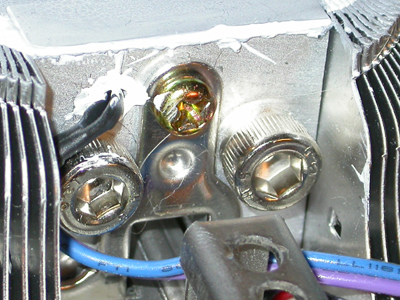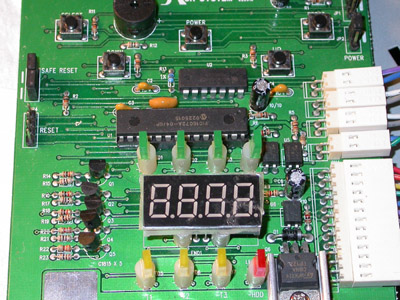CPU Heat Comparison: How Hot is Prescott?
by Derek Wilson on April 16, 2004 4:32 AM EST- Posted in
- CPUs
Heatsink Modding: The New Rage
Our solution to the problem is admittedly a bit of a kludge. Nothing is perfect, but we really wanted numbers that were going to get us some useable data, so we needed to get as close to measuring the surface temperature of a processor as possible.We decided to drill a hole in a heatsink and drop in a thermister.
Our heatsink of choice was the Zalman CNPS7000A-AlCu. In order to get something consistent between processors, we wanted to measure the temperature at the center of the heatsink close to the surface that would contact the processor. We drilled in from the side of the block to the center of the copper strip. Since the retention mechanism was held in by a screw in the center of the side, we had to go in at an angle. Please do not try this at home, as flying metal shards and angled drilling into a block of metal are not things we want to be sued over should something go wrong. Here's a look at what we ended up with:

This is a close up of the side of our modded heatsink.
This heatsink fit on all the processors we wanted to test, and we were assured that degrading its cooling ability a little by drilling a hole in it would still allow it to keep the CPUs cool enough to run. We hooked up a thermistor that came with a case we had, and since it was already set up for displaying temps, we forewent building a reader for it ourselves and just ripped out the front panel as well.

This is the front panel display we used to read the temperatures.
Some care needs to be taken when reading the data that we collected using this heatsink. First of all, this isn't a measure of the heat output of a processor. This is a measurement of the temperature at a specific position in an open system. Having the misfortune of suffering through a thermodynamics class in college isn't always a bad thing (except with respect to one's GPA), but what this means is that these numbers still aren't perfect. The processor is heating the bottom of the heatsink, while the fan is cooling the rest of it. Even though the heat is being distributed through the heatsink, if there is a hot or cold spot very close to the position from which the thermister was reading temperatures, the data could be off for that particular processor. Because we are heating and cooling this object at the same time, the equilibrium temperature we find at this position may not be directly proportional to the heat output of the chip.
But, with all that said, this is still better than using the on die thermistor or monitoring change in system temperature. Our tests were performed in a temperature controlled room with no case on the computer. In order to load the processors, we ran two simultaneous instances of Prime95 for 40 minutes (though temperatures stabilized after about 25). Our idle temperatures were taken after powering up and doing nothing for 30 minutes (no power saving options were enabled).










48 Comments
View All Comments
Xentropy - Monday, April 19, 2004 - link
"Most of us here are not mindless zealots who believe everything we read."Unless it's anti-Intel propaganda.
"but i have seen a prescot melt motherboards"
Have you? How many motherboards? Online in some forum or on HardOCP or whatever doesn't count. Personally seen, in person, how many?
Pumpkinierre - Sunday, April 18, 2004 - link
#46 I thought that was standard with Win XP. When I looked at the idle temps., I thought that might be the problem. On my K6-3/Win98, I run Rain which does the same thing. Good Post!lesovers - Sunday, April 18, 2004 - link
The main reason the AMD XP chips are so much hotter at ilde is they do not normally implement the HALT command like the P4s. The VIA KT chipsets (266, 333 and 400) have registers that can enable the CPU to HALT. Link for this is:http://www.ocmodshop.com/default.aspx?a=125%20
My XP2000 cool down be by about 20C at idle with the chipset registers changed !!!!!!
boardsportsrule - Saturday, April 17, 2004 - link
ok wow, how can you have a 3.2 prescot be at 34C with a medeocer heatsink, when i see people complain about high temps with their 2.8 prescott using a sp-94...then onto how could a 2600+ be hotter then a 3.2 prescott...i havent seen a 2600+ melt a motherboard, but i have seen a prescot melt motherboards... this stinks of intel...wounder howmuch they are paying him?ZobarStyl - Saturday, April 17, 2004 - link
This processor is supposed to carry Intel through something like 4.0+ GHz when Tejas gets here; if it's this hot against a Northwood, how do they expect to hit past 3.8 or so without watercooling or Prometia's built into standard desktops. The question isn't whether or not Prescott is a bad processor (it's not a disaster of Williamette proportions) but whether or not it can carry the weight Intel is slated to heft onto it's back for the next cycle.mindless1 - Saturday, April 17, 2004 - link
Margalus, get a grip!Even INTEL specs it to run that much hotter. Will you not even believe Intel?
mechBgon - Saturday, April 17, 2004 - link
Margalus, I've seen several Forum members try the Prescott and go back to their Northwoods because the Prescott was running very, very hot and/or doing scary stuff to their motherboards. And these are neither AMD zealots nor newbies. IIRC one of them is running a Prometia phase-change cooling system and another is running watercooling.Margalus - Saturday, April 17, 2004 - link
I can't believe the number of amd fanatics that just can't accept reality. the prescott is not as hot as the anti intel fanatics are saying. This article was pretty well done for the comparisons they did. All of you saying how it is bs have never even used a prescott, you just listen to clueless people like cramitpal who haven't even passed 3rd grade yetAIWGuru - Saturday, April 17, 2004 - link
"Of course, we'll be there to test it out as soon as we can get ahold of a 64bit enabled chip."Why are you waiting for a 64 bit prescott? Why not use the A64 you already have?
AIWGuru - Saturday, April 17, 2004 - link
Coruscant, your understanding is incorrect.What you're TRYING to describe is the flow of (thermal) energy to the path with the least resistance - the movement of hot to cold.
What you forgot to take into account is that once the heatsink starts to "absorb" heat it may quickly cease to become the path of least resistance.
Regardless, this test is fundamentally USELESS as, unless the dissipation rate of the heatsink has been exceeded, any measurement will be the same.
Because heat does not build up on a linear scale, any measurement above that level will also be innacruate.
The placement of the probe is also somewhat stupid.